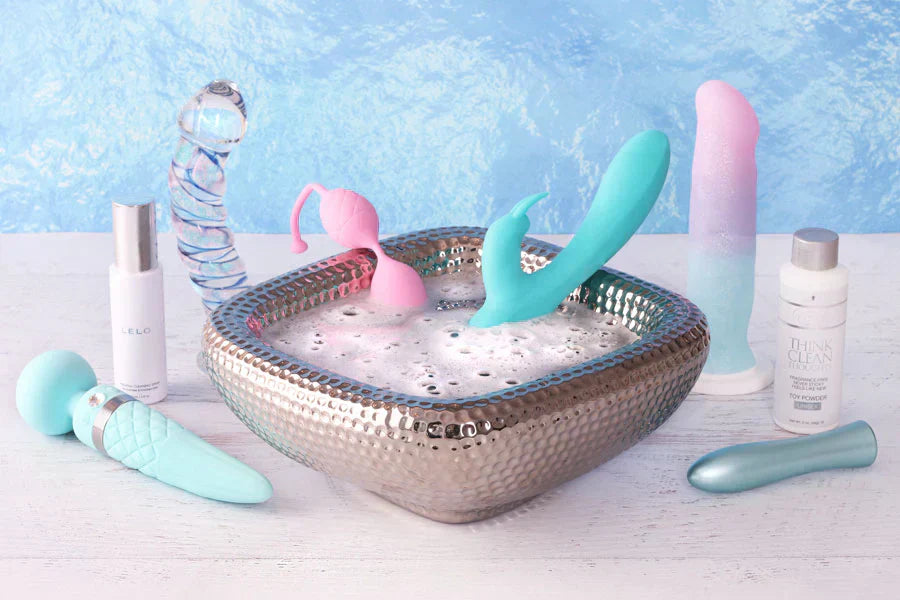How to Safely Clean Your Sex Toys
Properly cleaning your sex toys is an essential aspect of sexual wellness, ensuring not only personal hygiene but also the longevity and performance of your toys. However, sex toys are made from a wide range of materials, and not all cleaning methods are created equal. Using the wrong technique can damage the toy or worse, create a risk for infections.
This guide offers a comprehensive breakdown of cleaning methods by material type, highlights the differences between porous and non-porous toys, and provides best practices for maintaining a safe and hygienic experience.
Why Cleaning Sex Toys Is Critical
Sex toys come into contact with bodily fluids, lubricants, and sometimes multiple users. Without proper cleaning, bacteria, yeast, and viruses (such as HPV and herpes simplex) can linger on the toy's surface or within its material. Even toys used solo should be cleaned both before and after each use to prevent contamination and preserve their integrity.
Regular cleaning helps:
- Prevent the spread of STIs and infections
- Maintain the toy's material and function
- Reduce odour and build up
- Extend the lifespan of the toy
Understanding Material Differences: Porous vs. Non-Porous
Porous Materials
Porous materials have microscopic openings that can trap bacteria and bodily fluids even after washing. These materials are more difficult to sanitize fully, and therefore are not ideal for shared use unless a barrier (like a condom) is employed.
Common porous materials include:
- Jelly rubber (PVC with plasticizers)
- Thermoplastic elastomer (TPE) or thermoplastic rubber (TPR)
- Cyberskin, Superskin, or other "realistic feel" materials
- Latex (non-medical grade)
These materials are generally softer and less expensive but break down faster over time. They can become sticky or discoloured with use, and may retain odours or harbour bacteria even with regular cleaning.
Non-Porous Materials
Non-porous materials do not absorb fluids, making them easier to clean and safer for both solo and shared use when properly sanitized. These are generally more durable, higher-quality, and longer-lasting.
Common non-porous materials include:
- Medical-grade silicone
- Borosilicate glass (e.g., Pyrex)
- Stainless steel (body-safe grade)
- ABS hard plastic
- Glazed ceramic
Non-porous toys are more suitable for sterilization methods such as boiling, UV light, or alcohol-based cleaning.
Cleaning Methods by Material Type
Silicone (Medical-Grade)
Properties: Non-porous, hypoallergenic, durable.
Cleaning Methods:
- Basic Cleaning: Use warm water and a mild, fragrance-free soap. Rinse thoroughly and air dry.
- Deep Cleaning: If the toy is not electronic, boil for 5 to 10 minutes to fully sanitize.
- Dishwasher Option: Run on the top rack with no detergent if the toy is solid silicone and free of electrical components.
Cautions: Do not use silicone-based lubricants, as they can degrade the surface over time.
Glass (Borosilicate/Pyrex)
Properties: Non-porous, smooth, durable, temperature-play friendly.
Cleaning Methods:
- Wash with warm water and mild soap.
- Boil or use a dishwasher for thorough sterilization (no soap needed).
- Rubbing alcohol can be used for quick disinfection.
Cautions: Check for cracks or chips before each use. Avoid dropping or subjecting to thermal shock (e.g., boiling immediately after freezing).
Stainless Steel
Properties: Non-porous, ultra-durable, safe for all lubricants.
Cleaning Methods:
- Use soap and warm water or disinfect with 70% isopropyl alcohol.
- Boil for 10 minutes for sterilization.
- Can also be run through the dishwasher with no detergent.
Cautions: Check for pitting or corrosion if the toy is not labelled as body-safe grade stainless steel.
ABS Plastic
Properties: Non-porous, smooth, often used in vibrators.
Cleaning Methods:
- Wipe down with warm water and mild soap, being careful not to submerge unless waterproof.
- Disinfect with isopropyl alcohol or toy-safe cleaners.
Cautions: Do not use abrasive scrubs, which can scratch the surface and harbour bacteria.
Jelly, TPE, TPR, Cyberskin, Latex
Properties: Porous, soft, often lifelike in feel.
Cleaning Methods:
- Wash immediately after use with warm water and gentle soap.
- Allow to fully air dry before storage.
- For Cyberskin or similar materials, apply corn starch once dry to preserve texture.
Cautions: Avoid using alcohol, bleach, or hydrogen peroxide. These can degrade the material. Always use a condom with these toys if sharing.
Vibrating or Electronic Toys
Cleaning Methods:
- If labelled waterproof: wash under running water with soap, avoiding ports and seams.
- If not waterproof: use a damp cloth with mild soap, and follow up with a toy-safe cleaner or alcohol wipe.
- Clean around buttons and seams with a soft brush or cotton swab.
Cautions: Never submerge non-waterproof toys. Ensure all parts are dry before recharging or storing.
Natural Cleaning Alternatives
If you're looking to avoid commercial cleaners or simply want to use household items for cleaning, there are natural solutions that can be effective—especially for non-porous toys.
Important: Natural cleaners are not always sufficient for porous materials, which may require more aggressive sanitation or may not be fully sanitisable at all.
Vinegar Solution (for non-porous materials only)
- Mix 1 part white vinegar to 3 parts water
- Wipe down or soak non-electronic toys for 10 minutes
- Rinse thoroughly with warm water
- Air dry completely
Note: Vinegar has mild antibacterial properties, but it is not a full disinfectant and should not be used on toys that require sterilization after shared use.
Baking Soda Paste
- Create a paste with baking soda and water
- Use to scrub non-porous toys gently
- Rinse well and let dry
- Can help remove odour or light discoloration
Note: Avoid using baking soda on soft or porous materials; its abrasiveness can damage the surface.
Hydrogen Peroxide (3%)
- Can be used to disinfect non-porous toys
- Pour or spray directly on the toy, let sit for 5–10 minutes
- Rinse thoroughly and dry
Caution: Do not use hydrogen peroxide on porous or delicate materials. It can degrade them and may leave behind residue if not rinsed well.
Common Myths About Cleaning Sex Toys
Myth #1: You can use bleach to sanitize any toy.
Truth: Bleach is too harsh for most toy materials and can cause surface damage. It can also leave behind harmful residues.
Myth #2: If it looks clean, it is clean.
Truth: Bacteria and viruses can survive on surfaces that appear spotless. Cleaning must be done with proper methods and materials, not just visually.
Myth #3: All silicone is the same.
Truth: Only medical-grade silicone is fully non-porous. Some cheaper products marketed as “silicone” may be blended with other materials that compromise safety and cleanability.
Myth #4: Soap and water are enough for shared toys.
Truth: Soap and water are great for solo use, but shared toys (especially those used for anal or vaginal penetration) require sanitization or a barrier (like condoms) to be safe.
Additional Safety and Storage Tips
- Use the Right Lubricant: Water-based lubes are safe for all toy types. Avoid silicone-based lubes on silicone toys, and check compatibility labels.
- Store Properly: Keep toys in individual storage bags or cases to prevent material degradation and contamination.
- Inspect Regularly: Replace toys that change colour, become sticky, smell odd, or develop tears or cracks.
- Label Shared Toys: If you’re using toys with multiple partners, consider designating specific ones or using condoms to avoid cross-contamination.
In Summary
Cleaning your sex toys thoroughly and according to their material is not just a recommendation—it’s essential for your health and for maintaining the quality of your investment. By understanding the specific needs of different materials and adopting good cleaning habits, you can enjoy safer, more satisfying play for years to come.
When in doubt, always refer to the manufacturer’s care instructions, and when a toy starts to show signs of wear, err on the side of caution and replace it. If you need anymore advice please do not hesitate to contact us at Sexy Emporium.


